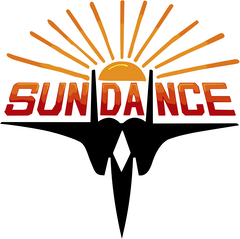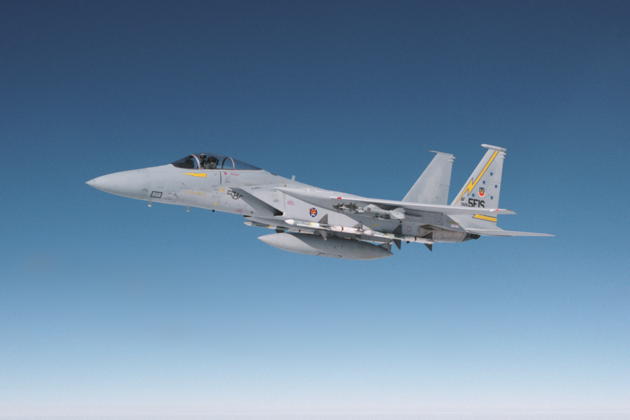FlightLog Archive
∟Aircraft Flown
Rancher Bob Flies with an Eagle - Sep 1985
In the mid-80's, I was involved with an Air Force team developing tactics and evaluating capabilities against the emerging cruise missile threat. One of our efforts involved flying F-15s, F-16s and other aircraft in combination with AWACS to assess our detection capability and missile effectiveness against surrogate US cruise missiles. As the squadron Weapons and Tactics officer, I had deployed with another F-15 Eagle to Hill AFB, near Salt Lake City, Utah to fly against cruise missiles in a major test over the Utah test ranges. The test involved an air launched cruise missile surrogate launched from a B-52, with numerous C-135 support aircraft, an AWACS controlling from the edge of the range, and various fighter assets, including my F-15s, F-16s from Hill, F/A-18s from the Navy, plus support F-4s from Edwards. My mission was to work with AWACS on the best detection strategies, and also assess the onboard capabilities of my APG-63 radar, optimum search and detect modes, and also to assess detection and lock-on ranges of my AIM-9L and AIM-9M Sidewinder IR missiles. We would later conduct live fire exercises over the Pacific using AIM-7F and AIM-7M radar guided missiles, but that's another story.
Today's test involved an early morning launch of the cruise missile surrogate on the edge of the range by the B-52, with an extensive set of waypoints that the missile would follow while AWACS and the fighter forces went through numerous intercepts. Since the airborne time of the cruise missile was measured in many hours, we divided our fighter assets to provide maximum opportunities for intercepts and engagements. I decided to take the first window, and briefed at 0430 for my 0630 takeoff time, with my wingman scheduled for launch at 0830, after the F-16s and F/A-18s made their attempts.
The sun was just rising as I blasted off from Hill AFB in the crisp fall air into a gloriously clear Utah sky. I turned westbound and began building my situational awareness of the aircraft already in the airspace, and quickly acquired the AWACS in its orbit, the B-52 positioning to the north, and the C-135s in their observation orbits. I also acquired a few low/slow tracks, most squawking the VFR traffic code of 1200 in their Mode 3 transponder, but they were well outside the restricted area. Except for one...
Just inside the restricted airspace on the western edge was a slow track at 7500 feet, not squawking, but definitely in the area. Just as I was acquiring the track, AWACS called: "Eagle 01, you're now cleared into the airspace, and we're wondering if you could give us a hand." "Go ahead", I replied. "Eagle 01, the launch is still on schedule for 20 minutes from now, but we have an unknown track now entering the western edge of the airspace that we'd like you to check out for us". I confirmed the bogey that I had at 7500 feet and about 50 miles out was the same contact, and noted his airspeed at about 125 knots. "That's the one", AWACS replied, as I started a descent from my current 37,000 feet altitude to a better altitude to ID the track.
My F-15 was also equipped with a simple rifle scope that we had mounted on the right side of our HUD for better long-range visual acquisition, and as I descended I slowed from my 500 knot speed to a more reasonable rejoin speed, in case I had to get close to the target. Coming from the east out of the rising sun, I was able to make out a high-winged light aircraft through the Eagle Eye scope as I rejoined, still about 8 miles out. "AWACS, it looks like a Cessna 180, heading about 030 degrees, level at 7500 feet", as I rounded the corner on the intercept to the target's six o'clock. "Eagle 01, thanks. Can you get his N-number for us?" No problem, I thought, as I continued to slow and rolled out about 1500 feet behind and to the right of the Cessna. As I got closer, I had a hard time picking up an N-number, expecting the typical 10-inch N-number along the side. I remembered, however, that the FAA had allowed 3-inch N-numbers recently, and I was realizing I had to get in VERY close to get the N-number on this Cessna.
I closed to about 50 feet out on the right aft of the Cessna, lowered my flaps, and finally saw and read out the N-number to the waiting AWACS. They asked me to shadow the target for a bit longer, but my 150-knot minimum speed was causing me to pull abeam the Cessna on his right side. As I flew slightly forward, I could finally see into the cockpit of the well-worn Cessna 180, now only 25 feet off my left wingtip. Inside the cockpit, the sole occupant, Rancher Bob, was visible in his flannel shirt, with his left hand on the yoke, and his right hand bringing a large thermos of coffee up to his mouth. Just then, the shadow of my F-15 blocked out the rising sun, and I saw Rancher Bob slowly look to his right - as all hell broke loose in his airplane!
With my AIM-9 missiles only a few feet from his right wingtip, Rancher Bob's eyes and mouth opened in shock, and I saw his thermos bottle drop down into his lap as his wings started rocking and the Cessna began gyrating while Rancher Bob reacted from the joint shock of my Eagle and the hot coffee! I eased out to the right, lit my burners and executed a climbing chandelle over the still-rattled Rancher Bob, keeping him in sight as he finally stabilized his aircraft. With my last view into his cockpit, I saw him reaching for a handheld mic, and within a minute he started a left turn to the west and began beating feet, as fast as he could, to get out of the restricted area.
I rolled out again at his six o'clock, and noted he had started squawking Mode 3/1200, and I tracked him until he exited the restricted airspace. About that time, AWACS passed their thanks for the N-number, and stated "Oh, by the way, Eagle 01, that Cessna is squawking and talking to center right now, thanks for the help."
With the airspace sanitized, the cruise missile testing proceeded without a hitch, and I was even able to aid the visiting Edwards F-4s as their 'Seeing Eye F-15', since they could not acquire the cruise missile on radar or visually without some handholding.
After the mission debrief, we summarized our top lessons learned and outcomes. I couldn't help but picture Rancher Bob, probably now also on the ground at his 'debrief', thinking of his top lessons learned:
Do much better at map reading and flight planning
Don't try to sneak through the edge of restricted airspace
Buy a better lid for my coffee mug!
 KASPRZYK
KASPRZYK